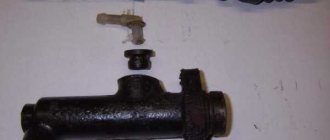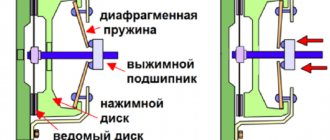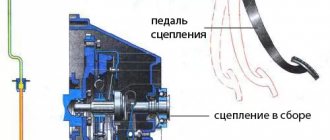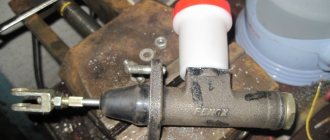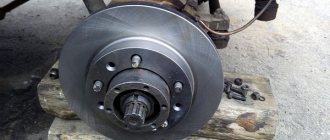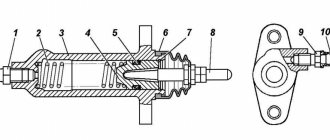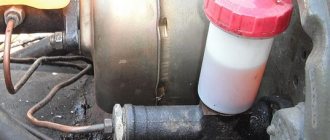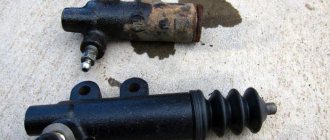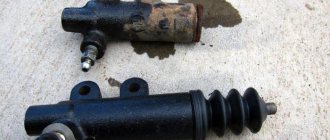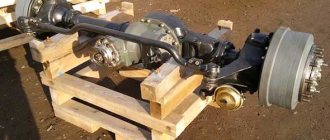The clutch is an important element in the design of a car, allowing you to “connect” the engine and gearbox, as well as realize the possibility of comfortable changing gears, eliminating shock loads, etc.
The clutch design on different cars may differ, while modern vehicles often use a hydraulic clutch. Among the main components of the hydraulic clutch system, the main cylinder (clutch master cylinder) should be highlighted.
The purpose of such a cylinder (sometimes called the clutch release cylinder) is to effectively transfer force from the clutch pedal to the clutch release fork. This fork presses the release bearing, which allows this mechanism to operate due to interaction with the clutch basket petals.
Signs of a GCS malfunction
When problems begin with the master cylinder, it most often manifests itself as a hydraulic fluid leak. When the clutch pedal begins to work poorly, the first stage of diagnosis will be a visual inspection: any leaks on the cylinder and even just slightly moistened seals are a sign of a problem that needs to be solved.
Basically, when there are problems with the cylinder, the clutch pedal begins to sink or move slowly, and the pedal “sticks” in the lower position.
Another problem with the GCS is clogging of the holes in the tank lid. For normal operation, the level in the cylinder reservoir must rise and fall freely, and for this purpose, ventilation holes are provided in the cover. If they become clogged with dirt, the hydraulic drive begins to work with difficulty: the pedal becomes stiffer and does not return well to its original position.
Possible malfunctions and their diagnosis
Signs indicating malfunctions in the clutch drive can be diagnosed based on the following:
- The level in the clutch reservoir has dropped significantly, this indicates that brake fluid is leaking somewhere in the system; if the connecting pipes are intact, this may be due to worn cuffs or a faulty piston in the master cylinder.
- A visual inspection showed the presence of places where fluid was leaking: tubes, cuffs, etc.
- When pressed, periodic failures of the pedal occur, this indicates that there is air in the clutch drive, this happens when hoses are cracked or when the level in the reservoir drops below “nowhere”.
- When shifting gears, a characteristic sound is heard in the gearbox, reminiscent of a “crunch”; the cause may be a malfunction of the piston or spring of the master cylinder.
Repair work
If the pedal fails, in order to avoid unreasonable disassembly of the cylinder, it is worth initially pumping the system and expelling air from there that could get in when the liquid in the tank drops below the minimum permissible level. If this does not help in principle, it is worth starting repairs. For this case, there is a repair kit for the clutch master cylinder on sale, which, depending on the make of the car, contains the main wearing parts: cuffs, return spring, rod, retaining ring, etc.
The master cylinder is located under the clutch pedal. Depending on the car model, dismantling will have to be done either from the engine compartment or from the car interior, having previously dismantled the floor covering in the driver’s area. Having removed the clutch master cylinder, we begin disassembling it, after which we need to wash all the parts
During the subsequent inspection, after disassembly, it is worth paying special attention to the body and the condition of the rod and mirror; if there are visible scuffs, this may indicate the appearance of wear in the cylinder or wear of the rod
In general, experienced craftsmen recommend changing all the parts in the repair kit, especially the cuffs.
When repairing the clutch master cylinder, it is advisable to follow some tips:
- in the event of a malfunction and subsequent repair of the cylinder, it is not possible to completely remove the fluid from the hydraulic drive;
- When washing parts, it is highly not recommended to use kerosene, diesel fuel and gasoline for this; after this, the cuffs and other rubber products may swell; the best option for washing is brake fluid;
- Before assembly, it would be useful to lubricate all parts with brake fluid; only the spherical surface of the rod in contact with the pusher needs to be treated with grease.
If faults are found that cannot be eliminated with the spare parts contained in the repair kit, then a complete replacement of the clutch master cylinder is necessary.
How to determine which clutch cylinder is not working
One of the main parts of the hydraulic drive of the clutch system, along with the main one, is the clutch slave cylinder.
The main task of this device is to transfer the force generated when the pedal is pressed and coming from the master cylinder through a hose to parts that directly interact with the gearbox: the clutch fork and the release bearing. Traditionally, the clutch slave cylinder is located on or next to the gearbox housing and is similar in its principle of operation and design in all car models, only the details differ: what the body, rod, etc. are made of.
To independently repair or replace this part, you need to understand the principle of its operation, the main components located in its body and the signs of possible malfunctions.
Operating principle and design
By pressing the pedal, there is an impact on the main cylinder, where pressure is created, as a result of which hydraulic fluid enters the working cylinder through the hose and discharge valve and, through the rod, actuates the pusher, which, by squeezing the fork, helps to engage or disengage the selected gear.
The design of the working cylinder shown in the photo is not as complicated as it might seem at first glance. It consists of the following main parts:
respectively, the body itself, which can be plastic or iron; an air release valve located on it, which is used when pumping; return spring; working rod (piston); a pusher acting on the fork; retaining ring; rubber parts: o-rings and cuffs. all elements Clutch cylinder parts: 1 – housing; 2 – fitting; 3 – cap; 4 – pusher; 5 – sealing ring; 6 – piston; 7 – sealing ring; 8 – plate; 9 – spring; 10 – washer; 11 – retaining ring
Wear or malfunction of some of the above parts can lead to deterioration of the entire clutch system, which can be judged by certain signs.
Signs of possible problems
The following signs may indicate an impending repair or when the clutch slave cylinder will need to be replaced:
Visually, there is a sharp decrease in the level of brake fluid in the reservoir, which indicates a leak; the cause may be wear on the cuffs of the working cylinder or a violation of the integrity of the hose; this will also be visible in spots under the car.
A too soft stroke or periodic dips in the clutch pedal indicate air has entered the system; if there are no improvements in clutch operation during bleeding or they turn out to be temporary, then the slave cylinder should be inspected. If there are places on it from which liquid is flowing, this could be a crack in the body or a worn cuff, it should be repaired.
The clutch pedal gradually drops lower and lower, and problems are felt when shifting gears, adjusting the pedal height does not bring results, and the fluid level in the reservoir remains unchanged, this is a sign of a broken spring in the working cylinder, and accordingly it needs to be changed. Having discovered that the cause of deterioration in clutch performance is the slave cylinder, you should not immediately rush to extremes and change it completely. A clutch slave cylinder repair kit, such as the one in the photo, is available for sale.
The repair kit includes, depending on the make of the car, the main wearing parts: return spring, rod, cuffs, o-rings, etc.
Removing and repairing the working cylinder is not difficult, as described above; it is mainly located on the gearbox housing, which is clearly shown in the photo. Having unscrewed the fastening bolts and disconnected the pusher from the fork, prepare to remove the hose coming from the master cylinder. Since it contains hydraulic fluid, the hose must be plugged with a plug of suitable diameter. Some experts advise, after disconnecting the hose, to drain all the liquid, since, when drained, it will flush the hydraulic drive system of accumulated dirt.
We disassemble and repair the removed cylinder; if the body is metal, then you can clamp it in a vice; in the case of a plastic body, this should not be done to avoid possible damage.
After disconnecting the air valve, you need to remove the outer cuff, and then, depending on the design, remove the retaining ring to gain access to the stem. After disassembling, you should carefully inspect all the parts: spring, rod, cylinder mirror for mechanical damage.
Rinse everything with brake fluid; remember that you cannot use gasoline, diesel fuel, engine oil or water for this, as these liquids can lead to swelling of rubber parts. Reassemble the cylinder in reverse order.
When carrying out repairs, all rubber components: cuffs, O-rings, etc., regardless of their condition, are replaced with new ones.
If repair is not possible for any reason:
cracks were found on the body; large wear on the inner surface of the housing due to a faulty rod. You should purchase a new slave cylinder and replace it completely. Bleeding the system, adjusting the pedal
Having installed the repaired or new cylinder in place, connecting a hydraulic hose to it, you should bleed the system and adjust the height of the clutch pedal. Bleeding after replacing the working cylinder is done in the same way as that done after repairing the master cylinder, but in some brands of cars, for example Fiat, this procedure is done the other way around. To “reverse” pumping yourself, you will need:
a hose of such a diameter that it fits tightly onto the outlet valve; a special or just a large syringe with a spout diameter suitable for the hose; key for unscrewing the air release valve.
Unscrew the lid of the fluid reservoir. We fill the syringe with hydraulic fluid and expel all the balloons from it, connect one end of the hose to the valve, the other to the syringe. After unscrewing the air valve a couple of turns, press the syringe and inject the liquid into the cylinder. Without removing the hose, tighten the valve so that no air gets in.
This procedure should be performed several times until the final release of air from the system into the tank. Then press the clutch pedal up to ten times and, if necessary, adjust its height.
When is the best time to repair the clutch slave cylinder?
Replacing the cylinder is a last resort. Repair kits on sale are becoming less and less reliable. But it is possible to determine whether a part can be repaired only after removing and disassembling the control center. It is necessary to check the internal mechanisms, especially the seals and spring. If most of the parts are damaged, it is better not to carry out repairs. Naturally, a cylinder whose body even has a small crack will go to landfill. In addition, it is advisable to immediately replace polymer and aluminum models.
First, dismantle the protective cap along with the pusher, then the retaining ring and sealing collars. After this, you can check the operation of the spring. You should make sure that the hole in the air release fitting is clean, that there is no damage to the outer surface of the piston and the inside of the RCS housing.
When choosing a new RCS, pay attention to products from the brands Sachs, Lukas, Fenox. These companies have been on the market for a long time, their parts are considered the highest quality.. https://www.youtube.com/embed/ixlC52SDEF8
